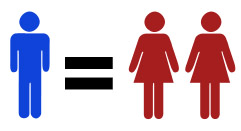Template:Pictorial-Islam-options: Difference between revisions
Jump to navigation
Jump to search
| [checked revision] | [checked revision] |
mNo edit summary |
mNo edit summary |
||
| Line 229: | Line 229: | ||
<option weight="1">{{Pictorial-Islam|1=To You Your Religion and To Me Mine (Qur'an 109:1-6)|2=[[File:Al-Kafirun.png|215px|link=To You Your Religion and To Me Mine]]|3=This article analyzes the apologetic claim that Surat al-Kafiroon (the Disbelievers, Atheists) advocates religious tolerance and freedom. When read in context, like many other verses misinterpreted for apologetic purposes, Surat al-Kafiroon advocates the opposite of what is sometimes claimed. This surah is not a proclamation on religious tolerance and freedom or a recognition of religious pluralism. In fact, this surah unequivocally forbids inter-faith dialogue and advocates an "us versus them" mentality between Muslims and disbelievers. This is how the surah is understood by mainstream Islam and the majority of its classical and contemporary scholars. Furthermore, if the historical context were to be ignored, it would still remain an abrogated verse superseded by "the verses of fighting". ([[To You Your Religion and To Me Mine|''read more'']])}}</option> | <option weight="1">{{Pictorial-Islam|1=To You Your Religion and To Me Mine (Qur'an 109:1-6)|2=[[File:Al-Kafirun.png|215px|link=To You Your Religion and To Me Mine]]|3=This article analyzes the apologetic claim that Surat al-Kafiroon (the Disbelievers, Atheists) advocates religious tolerance and freedom. When read in context, like many other verses misinterpreted for apologetic purposes, Surat al-Kafiroon advocates the opposite of what is sometimes claimed. This surah is not a proclamation on religious tolerance and freedom or a recognition of religious pluralism. In fact, this surah unequivocally forbids inter-faith dialogue and advocates an "us versus them" mentality between Muslims and disbelievers. This is how the surah is understood by mainstream Islam and the majority of its classical and contemporary scholars. Furthermore, if the historical context were to be ignored, it would still remain an abrogated verse superseded by "the verses of fighting". ([[To You Your Religion and To Me Mine|''read more'']])}}</option> | ||
<option weight="1">{{Pictorial-Islam|1=A Qur’anic Understanding of the Universe|2=[[File:Ancient-Cosmology.jpg|180px|link=A Qur’anic Understanding of the Universe]]|3=The Qur'an's understanding of the universe matches that of the mythical cosmos believed by 7th century Arabians rather than an accurate description of the real universe. In the Qur'an, the entire universe is very small and contains simply the earth and its surrounding heavens. There are no galaxies, other solar systems, or such a thing as “outer space.” The earth is the top-most of seven, flat discs, surrounded by the seven solid concentric domes of the heavens. The celestial objects that do exist (sun, moon, stars and planets) are quite small, very close, and they follow semi-circular paths within the innermost of the seven heavenly domes. When they are not in the sky above the earth, they are resting somewhere underneath it, except while petitioning Allah’s permission to return the following day (or night). Paradise exists between the seven heavens, and hell exists between the seven earths. All of this is submerged in a cosmic sea, above which is the throne of Allah. ([[A Qur’anic Understanding of the Universe|''read more'']])}}</option> | |||
</choose><!-- HELP NOTES: <option>{{Pictorial-Islam|1=TITLE OF STORY|2=IMAGE LINK (SEE ABOVE FOR EXAMPLE)|3=TEXT OF STORY - SHOULD INCLUDE READ MORE LINK}}</option> --><noinclude>[[Category:Templates]][[Category:Random Templates]]</noinclude> | </choose><!-- HELP NOTES: <option>{{Pictorial-Islam|1=TITLE OF STORY|2=IMAGE LINK (SEE ABOVE FOR EXAMPLE)|3=TEXT OF STORY - SHOULD INCLUDE READ MORE LINK}}</option> --><noinclude>[[Category:Templates]][[Category:Random Templates]]</noinclude> | ||
Revision as of 00:59, 17 May 2013
Also see: Template:Pictorial-Islam
|
